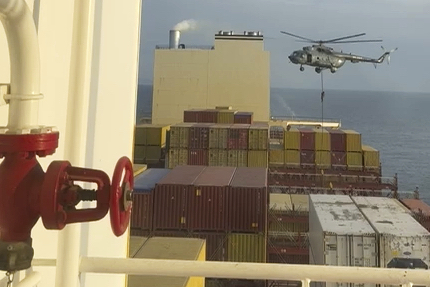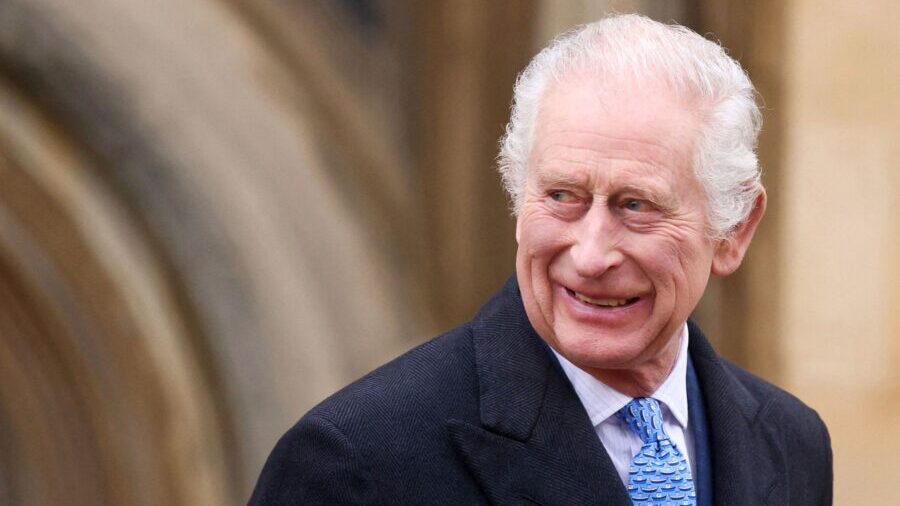US says it has downed some Iran-launched attack drones en route to Israel
Apr 13, 2024, 5:41 PM | Updated: 5:44 pm

This image made from a video provided to The Associated Press by a Mideast defense official shows a helicopter raid targeting a vessel near the Strait of Hormuz on Saturday, April 13, 2024. A video seen by The Associated Press shows commandos raiding a ship near the Strait of Hormuz by helicopter Saturday, an attack a Mideast defense official attributed to Iran amid wider tensions between Tehran and the West. The Mideast defense official spoke on condition of anonymity to discuss intelligence matters. (AP Photo)
(AP Photo)
JERUSALEM (AP) — U.S. forces have downed some Iran-launched attack drones flying toward Israel, according to a U.S. defense official and two U.S. officials who spoke on condition of anonymity to discuss the matter.
The defense official said the effort to intercept the attack was continuing.
Booms and air raid sirens sounded in Jerusalem early Sunday after Iran launched dozens of drones and ballistic missiles toward Israel in an unprecedented revenge mission that pushed the Middle East ever closer to a regionwide war.
The attack marked the first time Iran has launched a direct military assault on Israel, despite decades of enmity dating back to the country’s 1979 Islamic Revolution. Condemnation was swift, with France saying that “Iran has crossed a new threshold with regard to its destabilizing activities and is risking a potential military escalation.” Britain called the attacks “reckless.”
There was no immediate word from authorities on whether the explosions were an incoming attack or interceptions by air defense. Air raid sirens were reported in numerous places including northern Israel, southern Israel, the northern West Bank and the Dead Sea near the Jordanian border. Israel’s Magen David Adom rescue service said there were no reports of casualties.
Israel’s military said over 100 drones had been fired. It didn’t mention ballistic missiles, which are less easily shot down, but Iran said they were part of the attack. The U.S., with its large troop presence in the region, said it would provide unspecified support to Israel.
“We are monitoring the threat,” the Israeli military’s spokesman, Rear Adm. Daniel Hagari, announced in a nationwide television address.
Iran vowed revenge
Iran had vowed revenge since an April 1 airstrike in Syria killed two Iranian generals inside an Iranian consular building. Iran accused Israel of being behind the attack. Israel hasn’t commented on it.
Israel and Iran have been on a collision course throughout Israel’s six-month war against Hamas militants in the Gaza Strip. The war erupted after Hamas and Islamic Jihad, two militant groups backed by Iran, carried out a devastating cross-border attack on Oct. 7 that killed 1,200 people in Israel and kidnapped 250 others. An Israeli offensive in Gaza has caused widespread devastation and killed over 33,000 people, according to local health officials.
Almost immediately after the war erupted, Hezbollah, an Iranian-backed militant group in Lebanon, began attacking Israel’s northern border. The two sides have been involved in daily exchanges of fire, while Iranian-backed groups in Iraq, Syria and Yemen have launched rockets and missiles toward Israel.
In a statement carried late Saturday by Iran’s state-run IRNA news agency, the country’s paramilitary Revolutionary Guard acknowledged launching “dozens of drones and missiles towards the occupied territories and positions of the Zionist regime.”
IRNA later quoted an anonymous official saying ballistic missiles were part of the attack. A ballistic missile moves on an arch trajectory, heading up into space before gravity brings the weapon down at a speed several times faster than the speed of sound.
Defense missle systems
Israel has missile defense systems capable of targeting ballistic missiles. However, in a massive attack involving multiple drones and missiles, the likelihood of a strike making it through is higher.
Iran has a vast arsenal of drones and missiles. Online videos shared by Iranian state television purported to show delta-wing-style drones resembling the Iranian Shahed-136s long used by Russia in its war on Ukraine. The slow-flying drones carry bombs. Ukraine has successfully used both surface-to-air missiles and ground fire to target them.
Israel has a multilayered air-defense network that includes systems capable of intercepting a variety of threats including long-range missiles, cruise missiles, drones and short-range rockets.
Hagari, the army spokesman, said Israel was “prepared and ready” with defensive and offensive responses. But he cautioned that the air defenses are not 100% effective and urged the public to heed safety instructions.
The army ordered residents in the Golan Heights — near the Syrian and Lebanese borders — as well as the southern towns of Nevatim and Dimona and the Red Sea resort of Eilat “to stay near protective spaces until further notice.” Dimona is home to Israel’s main nuclear facility, and Nevatim has a major air base.
The army’s Home Front Command canceled school on Sunday and limited public gatherings to no more than 1,000 people. Israel closed its airspace and canceled all flights.
Earlier Prime Minister Benjamin Netanyahu warned: “Whoever harms us, we will harm them.”
President Biden cuts short a trip
In Washington, President Joe Biden cut short a weekend trip to his beach house in Delaware to return to the White House. He was set to convene a principals meeting of the National Security Council on Saturday to discuss the unfolding attack, the White House said.
“The United States will stand with the people of Israel and support their defense against these threats from Iran,” National Security Council spokesperson Adrienne Watson said in a statement.
Gen. Erik Kurilla, the head of the U.S. military’s Central Command, was in Israel over the weekend consulting with Israeli defense officials about the Iranian threat. The Central Command oversees U.S. forces in the Middle East.
Iran’s mission to the United Nations issued a warning to both Israel and the U.S. “Should the Israeli regime make another mistake, Iran’s response will be considerably more severe,” it wrote online. “It is a conflict between Iran and the rogue Israeli regime, from which the U.S. MUST STAY AWAY!”
For days, Iranian officials including Supreme Leader Ayatollah Ali Khamenei had threatened to “slap” Israel for its Syria strike.
In Iran’s capital, Tehran, witnesses saw long lines at gas stations early Sunday as people appeared worried about what may come next. Dozens of hard-liners demonstrated in support of the attack at Palestine Square.
Lebanon’s state-run National News Agency reported heavy Israeli airstrikes and shelling on multiple locations in south Lebanon following Iran’s launch of drones. The Lebanese militant group Hezbollah said it launched “dozens” of Katyusha rockets at an Israeli military site in the Golan Heights early Sunday. It was not immediately clear if there was any damage.
Countries in the region began to close their airspace.
Iran’s Revolutionary Guard seizes a container ship
Early Saturday, commandos from Iran’s paramilitary Revolutionary Guard rappelled from a helicopter onto an Israeli-affiliated container ship near the Strait of Hormuz and seized the vessel.
Iran’s state-run IRNA said a special forces unit of the Guard’s navy carried out the attack on the Portuguese-flagged MSC Aries, a container ship associated with London-based Zodiac Maritime.
Zodiac Maritime is part of Israeli billionaire Eyal Ofer’s Zodiac Group. Zodiac declined to comment and referred questions to MSC. Geneva-based MSC acknowledged the seizure and said 25 crew members were on the ship.
“We are working closely with the relevant authorities to ensure their well-being, and safe return of the vessel,” MSC said.
Watson, the White House National Security Council spokesperson, said the crew was made up of Indian, Filipino, Pakistani, Russian and Estonian nationals and urged Iran to release them and the vessel.
IRNA said the Guard would take the vessel into Iranian territorial waters.
A Middle East defense official, who spoke on condition of anonymity to discuss intelligence matters, provided video of the attack to The Associated Press in which Iranian commandos are seen rappelling onto a stack of containers on the vessel’s deck.
The video corresponded with known details of the MSC Aries. The commandos rappelled from what appeared to be a Soviet-era Mil Mi-17 helicopter, which both the Guard and the Iranian-backed Houthis in Yemen have used to raid ships.













